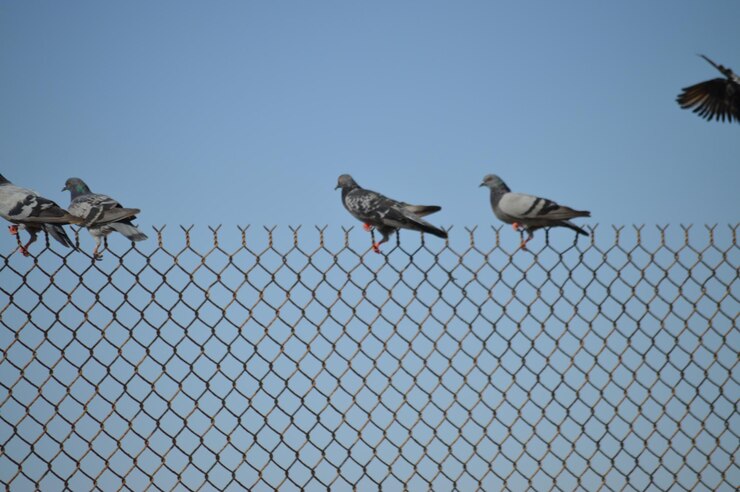Introduction
With the rapid rise in urban infrastructure and high-rise living, duct areas in buildings have become a necessary architectural feature for ventilation, pipelines, cables, and AC outlets. However, these open and often neglected spaces are frequently invaded by birds—especially pigeons—seeking shelter or nesting sites. While it may seem harmless at first, the consequences of bird infestations in duct areas can be serious, leading to hygiene concerns, foul odors, damage to wiring, and long-term structural issues.
The most effective and humane solution to this growing problem is the installation of bird and pigeon nets in duct areas. These nets are designed to block birds from entering without causing harm, thus maintaining cleanliness, safety, and peace of mind for building residents and property managers.
Why Are Birds Attracted to Duct Areas?
Ducts, especially in residential and commercial complexes, offer birds:
- Shelter from harsh weather
- Secluded spots for nesting
- Easy access through open vents or cavities
- Warmth from indoor heating systems and machinery
Pigeons are particularly notorious for nesting in Duct area bird& pigeon nets due to their adaptive behavior in urban settings. Once they settle, they return regularly and often in larger numbers, creating a cycle of infestation.
Problems Caused by Pigeons and Birds in Duct Areas
- Health Hazards
Bird droppings can carry diseases like histoplasmosis, salmonella, and cryptococcosis. Accumulated droppings in duct spaces can lead to airborne bacteria that may enter the building’s ventilation system. - Unpleasant Odors
Dead birds, droppings, and nesting materials produce a strong, unpleasant smell that can spread into homes or offices. - Allergens and Respiratory Issues
The dust from dried droppings and feathers can trigger allergies and respiratory problems, particularly in children and the elderly. - Structural and Aesthetic Damage
Bird droppings are acidic and can corrode building materials over time. Nesting materials may block vents, damage wires, or clog drainage systems. - Noise Pollution
Constant cooing or fluttering of birds inside the ducts can be a persistent nuisance, especially in quiet residential areas.
What Are Bird & Pigeon Nets?
Bird and pigeon nets are durable mesh barriers made from high-quality synthetic materials like HDPE (High-Density Polyethylene), which is UV-stabilized and weather-resistant. These nets are designed to cover open duct areas and prevent birds from entering while allowing proper ventilation and airflow.
Key Features of Duct Area Bird & Pigeon Nets
- Non-intrusive: Nets are installed in a way that does not damage the building structure or obstruct airflow.
- UV Resistant: Durable against heat and sunlight, ensuring long-lasting performance in outdoor conditions.
- Customizable: Can be tailored to fit duct sizes of all dimensions and shapes.
- Safe and Humane: Prevent birds from entering without harming them.
- Low Maintenance: Once installed, nets require minimal upkeep and can last for several years.
Benefits of Installing Bird Nets in Duct Areas
- Prevention of Infestation
By blocking access points, nets effectively prevent birds from nesting or perching in duct areas. - Enhanced Hygiene
Keeps the premises clean and reduces the risk of disease transmission from bird droppings. - Protection of Property
Avoid damage to pipelines, wiring, and vents caused by birds nesting or pecking. - Improved Air Quality
Clean ducts lead to cleaner air being circulated through AC or ventilation systems. - Increased Property Value
Well-maintained duct spaces contribute to the overall appearance and value of the property.
Installation Process
- Site Inspection:
A technician visits the location to assess the size, structure, and access to the duct area. - Measurement & Customization:
Based on the inspection, nets are cut and prepared to fit the area accurately without gaps. - Installation:
The nets are fixed using stainless steel hooks, nylon cords, or anchor bolts, ensuring firm support. - Quality Check:
Post-installation checks are done to ensure the net is secure and birds cannot enter.
Choosing the Right Net Provider
When selecting a bird netting service, consider the following:
- Experience in duct area installations
- Quality and warranty of the net material
- Use of corrosion-resistant fixing accessories
- Availability of AMC (Annual Maintenance Contract)
- Testimonials and customer reviews
Professional companies also ensure that installations comply with local safety and building regulations.
Environmental Considerations
Unlike harmful methods such as chemical repellents or spikes, bird nets are a humane and eco-friendly solution. They do not harm birds or the environment and are supported by animal welfare groups. They simply restrict access, encouraging birds to move to natural, safe habitats.
Conclusion
Duct area bird& pigeon nets In modern urban buildings, protecting duct areas with bird and pigeon nets is not just a precaution—it’s a necessity. These simple yet effective installations can save thousands in maintenance costs, promote health and hygiene, and preserve the aesthetic value of a property.
For housing societies, commercial buildings, hospitals, and institutions, investing in professional duct area bird netting is a long-term solution to a very common urban problem. It’s time to secure our spaces the smart and sustainable way.

